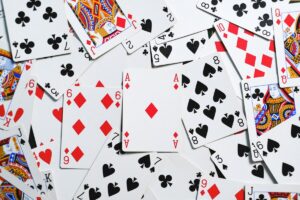 Blackjack, a.k.a. ‘twenty-one’, is a card game in which the aim is to outscore the dealer, or have the dealer ‘bust’ by having a points total exceeding twenty-one. The name ‘blackjack’ was derived from a bonus historically paid to players dealt the jack of spades or the jack of clubs and the ace of spades, but nowadays the term is used to describe any court card or ten and an ace, of any suit, dealt as the first two cards to a player during the game.
Blackjack, a.k.a. ‘twenty-one’, is a card game in which the aim is to outscore the dealer, or have the dealer ‘bust’ by having a points total exceeding twenty-one. The name ‘blackjack’ was derived from a bonus historically paid to players dealt the jack of spades or the jack of clubs and the ace of spades, but nowadays the term is used to describe any court card or ten and an ace, of any suit, dealt as the first two cards to a player during the game.
Blackjack is one of the most popular casino games in the world because it is easy to understand and offers a house edge of less than 1%, depending on the number of decks of cards – typically between one and eight – used in the game. Indeed, by using a set of rules, known as ‘basic strategy’, which describe the optimal way to play any hand, skilled players to reduce the house edge to around 0.5%.
In casino blackjack, before any cards are dealt, each player places one or more bets, depending on how many hands they wish to play at a time, in the designated area in front of them. Each player hand receives two cards, face down, while the dealer hand receives two cards, one of which, known as the ‘upcard’, is dealt face up. With the exception of blackjack, which outranks all other 21-point hands, the value of a hand is the sum of the individual cards; aces count as 1 or 11, court cards count 10 and all other cards count as face value.
Players may stand pat with their cards or draw one or more additional cards, but if total value of any hand exceeds 21, the hand ‘busts’ and the bet loses. Other options include doubling a bet, in return for one, and only one card, splitting a pair into two individual hands and surrendering a hand, which results in losing half, but only half, of the money staked on it.
